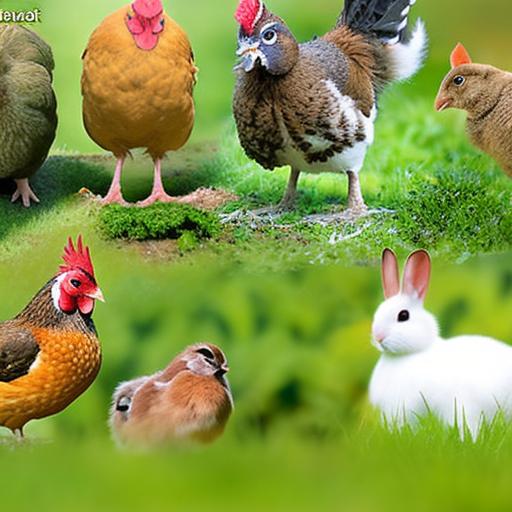Raising chickens and rabbits together is a practice that has gained popularity among homesteaders and small farmers. These two animals can be kept together in the same space, providing numerous benefits such as reduced feed costs and increased manure production. However, there are also challenges to consider when keeping chickens and rabbits together. In this article, we will explore the compatibility of these animals, the benefits of keeping them together, housing requirements, feeding considerations, health risks and precautions, behavioral issues and solutions, breeding and reproduction management, legal considerations, and ultimately help you decide if keeping chickens and rabbits together is right for you.
Key Takeaways
- Raising chickens and rabbits together is possible and can have benefits.
- Chickens and rabbits can be compatible if introduced properly and given enough space.
- Keeping chickens and rabbits together can save space and provide natural pest control.
- Housing requirements for chickens and rabbits should be separate but can be in close proximity.
- Feeding chickens and rabbits in the same space requires careful consideration and monitoring.
Compatibility of Chickens and Rabbits
Understanding the natural behavior of chickens and rabbits is crucial in determining their compatibility. Chickens are social animals that establish a pecking order within their flock. They scratch the ground for food, dust bathe, and roost at night. On the other hand, rabbits are more solitary creatures that dig burrows and graze on grasses. While these behaviors may seem incompatible at first glance, with proper management and planning, chickens and rabbits can coexist peacefully.
Some people have successfully kept chickens and rabbits together by providing separate areas for each species within the same enclosure. For example, a large fenced area can be divided into two sections: one for the chickens to roam freely and another for the rabbits to graze. This allows both animals to exhibit their natural behaviors without interfering with each other. Additionally, providing hiding spots or elevated platforms for rabbits can help reduce stress caused by the presence of chickens.
Benefits of Keeping Chickens and Rabbits Together
One of the main benefits of keeping chickens and rabbits together is reduced feed costs. Chickens are omnivores that require a balanced diet consisting of grains, vegetables, insects, and protein sources. Rabbits, on the other hand, are herbivores that primarily eat grasses and hay. By allowing chickens to forage in the same area as rabbits, they can consume insects and vegetation, reducing the need for additional feed.
Another advantage of keeping chickens and rabbits together is increased manure production. Both animals produce nutrient-rich manure that can be used as fertilizer for gardens or crops. By combining their manure, you can create a more potent and balanced fertilizer that promotes healthy plant growth. This is especially beneficial for homesteaders and small farmers who rely on sustainable practices and want to minimize their environmental impact.
Housing Requirements for Chickens and Rabbits
When it comes to housing requirements, chickens and rabbits have different needs that must be taken into consideration. Chickens require a secure coop that protects them from predators, provides roosting space, nesting boxes, and access to fresh air and sunlight. Rabbits, on the other hand, need a hutch or cage that allows them to move around freely, provides hiding spots, and protects them from extreme weather conditions.
To accommodate both animals in the same space, it is important to design a coop or hutch that meets the needs of both species. This can be achieved by dividing the space into separate sections using wire mesh or solid barriers. The chicken section should have roosting bars, nesting boxes, and a secure door to prevent rabbits from entering. The rabbit section should have hiding spots, elevated platforms, and a separate feeding area to prevent chickens from consuming their food.
Keeping the coop or hutch clean and sanitary is essential for the health of both animals. Regularly removing droppings, providing fresh bedding, and ensuring proper ventilation will help prevent the buildup of ammonia and reduce the risk of respiratory issues. Additionally, providing dust bathing areas for chickens and litter boxes for rabbits will help maintain cleanliness and hygiene.
Feeding Chickens and Rabbits in the Same Space
Feeding chickens and rabbits in the same space can be done successfully with proper planning and management. Chickens require a balanced diet consisting of grains, vegetables, insects, and protein sources. Rabbits, on the other hand, primarily eat grasses and hay. It is important to provide each animal with the appropriate nutrition to ensure their health and productivity.
One way to feed both animals in the same space is by providing separate feeding areas. This can be achieved by using feeders that are specifically designed for each species. For example, hanging feeders can be used for chickens, while low-lying feeders can be used for rabbits. This will prevent chickens from consuming rabbit food and vice versa.
Another option is to provide a mixed diet that meets the nutritional needs of both animals. This can be achieved by offering a combination of grains, vegetables, hay, and protein sources in a single feeder. However, it is important to monitor the intake of each animal to ensure they are receiving the appropriate amount of food.
Health Risks and Precautions to Consider

Keeping chickens and rabbits together can pose certain health risks that need to be considered. Both animals are susceptible to diseases and parasites that can be transmitted between species. It is important to take precautions to prevent the spread of these pathogens and ensure the health of both animals.
One way to prevent the spread of diseases is by practicing good biosecurity measures. This includes keeping the coop or hutch clean and sanitized, quarantining new animals before introducing them to the existing flock or herd, and regularly monitoring the health of each animal. Additionally, providing separate water sources for chickens and rabbits will help prevent cross-contamination.
Parasites such as fleas, mites, and worms can also affect both chickens and rabbits. Regularly inspecting each animal for signs of infestation and treating them accordingly will help prevent the spread of parasites. It is important to consult with a veterinarian to determine the appropriate treatment options for your specific situation.
Behavioral Issues and Solutions
When keeping chickens and rabbits together, certain behavioral issues may arise that need to be addressed. Chickens can exhibit aggressive behavior towards rabbits, especially if they feel threatened or if resources such as food and water are limited. Additionally, rabbits may display territorial behavior and become stressed by the presence of chickens.
To address aggression between chickens and rabbits, it is important to provide separate areas for each species within the same enclosure. This will allow them to establish their own territories and reduce the likelihood of conflicts. Additionally, providing hiding spots or elevated platforms for rabbits will help them feel safe and secure in the presence of chickens.
Creating a peaceful environment for both animals is essential for their well-being. This can be achieved by providing ample space, enrichment activities, and opportunities for social interaction. Regularly monitoring their behavior and addressing any signs of stress or aggression will help maintain a harmonious relationship between chickens and rabbits.
Breeding and Reproduction of Chickens and Rabbits
Managing breeding and reproduction when keeping chickens and rabbits together requires careful planning and consideration. Both animals have different reproductive cycles and behaviors that need to be taken into account.
Chickens are prolific breeders that require nesting boxes and a rooster for fertilization. If you do not want to breed chickens, it is important to separate hens from roosters or use non-fertile eggs for consumption. Rabbits, on the other hand, are induced ovulators that can breed year-round. It is important to separate males from females when not intending to breed or use appropriate contraception methods.
When breeding chickens and rabbits together, it is important to ensure that both animals are healthy and productive. Providing a balanced diet, monitoring their reproductive cycles, and providing appropriate nesting areas will help maximize fertility and ensure successful breeding.
Legal Considerations for Keeping Chickens and Rabbits Together
Before keeping chickens and rabbits together, it is important to consider the legal requirements and regulations in your area. Some municipalities have specific laws regarding the keeping of livestock or the number of animals allowed per property. It is important to familiarize yourself with these regulations and obtain any necessary permits or licenses.
Additionally, it is important to consider the zoning restrictions in your area. Some neighborhoods or residential areas may not allow the keeping of livestock or may have specific restrictions on the type or number of animals allowed. It is important to respect these regulations and ensure that your animals are kept in a manner that is compliant with local laws.
Is Keeping Chickens and Rabbits Together Right for You?
Keeping chickens and rabbits together can be a rewarding experience for homesteaders and small farmers. The benefits of reduced feed costs and increased manure production make it an attractive option for those looking to maximize their resources. However, it is important to consider the challenges and requirements associated with keeping these animals together.
By understanding the compatibility of chickens and rabbits, providing appropriate housing, managing feeding requirements, taking precautions against health risks, addressing behavioral issues, managing breeding and reproduction, and complying with legal considerations, you can create a harmonious environment for both animals.
Ultimately, the decision to keep chickens and rabbits together depends on your own situation and needs. Consider factors such as available space, time commitment, resources, and local regulations before making a final decision. If you are willing to put in the effort and provide proper care for both species, keeping chickens and rabbits together can be a beneficial and rewarding endeavor.
If you’re considering keeping chickens and rabbits together, it’s important to understand the dynamics between these two animals. While they can coexist peacefully, there are certain factors to consider. In a related article on Poultry Wizard, you can learn more about the compatibility of chickens and rabbits as well as tips for successful cohabitation. Discover how to create a harmonious environment for both species by visiting https://poultrywizard.com/keeping-chickens/how-to-keep-chickens-and-rabbits-together/.
FAQs
Can you keep chickens with rabbits?
Yes, it is possible to keep chickens with rabbits in the same enclosure.
What are the benefits of keeping chickens and rabbits together?
Keeping chickens and rabbits together can provide mutual benefits such as sharing the same living space, reducing the risk of predators, and providing companionship for each other.
What are the potential risks of keeping chickens and rabbits together?
The potential risks of keeping chickens and rabbits together include territorial disputes, aggression, and the spread of diseases between the two species.
How can you prevent territorial disputes between chickens and rabbits?
To prevent territorial disputes between chickens and rabbits, it is important to provide enough space for both species to live comfortably and establish their own territories. Additionally, providing separate feeding and watering stations can help reduce competition and aggression.
What are some diseases that can be spread between chickens and rabbits?
Some diseases that can be spread between chickens and rabbits include coccidiosis, salmonella, and pasteurellosis. It is important to keep both species clean and healthy to prevent the spread of diseases.
What should you consider before keeping chickens and rabbits together?
Before keeping chickens and rabbits together, it is important to consider the space requirements, the temperament of each species, and the potential risks and benefits. It is also important to research and understand the specific needs of each species to ensure their health and well-being.
Meet Walter, the feathered-friend fanatic of Florida! Nestled in the sunshine state, Walter struts through life with his feathered companions, clucking his way to happiness. With a coop that’s fancier than a five-star hotel, he’s the Don Juan of the chicken world. When he’s not teaching his hens to do the cha-cha, you’ll find him in a heated debate with his prized rooster, Sir Clucks-a-Lot. Walter’s poultry passion is no yolk; he’s the sunny-side-up guy you never knew you needed in your flock of friends!







